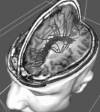The magnetic resonance revolution in brain imaging: impact on neonatal intensive care
- PMID: 15102717
- PMCID: PMC1721681
- DOI: 10.1136/adc.2003.027334
The magnetic resonance revolution in brain imaging: impact on neonatal intensive care
Figures




Similar articles
-
[Cerebral brain injury in preterm infants and the role of neuroimaging in predicting neurodevelopmental outcomes].Rev Med Suisse. 2014 Feb 19;10(418):442-9. Rev Med Suisse. 2014. PMID: 24640280 French.
-
The predictive validity of neonatal MRI for neurodevelopmental outcome in very preterm children.Semin Perinatol. 2015 Mar;39(2):147-58. doi: 10.1053/j.semperi.2015.01.008. Epub 2015 Feb 25. Semin Perinatol. 2015. PMID: 25724792 Review.
-
[Epoch-making ideas in care of skull injuries. New intensive care based on integrated physiology].Lakartidningen. 1994 Dec 14;91(50):4729-37. Lakartidningen. 1994. PMID: 7830424 Review. Swedish. No abstract available.
-
Advances in magnetic resonance imaging of the injured neonatal brain.Pediatr Ann. 2008 Jun;37(6):395-402. doi: 10.3928/00904481-20080601-09. Pediatr Ann. 2008. PMID: 18616193 Review. No abstract available.
-
Magnetic resonance imaging of the neonatal brain.Hosp Med. 1998 Jan;59(1):41-5. Hosp Med. 1998. PMID: 9798564 Review.
Cited by
-
Role of cerebral function monitoring in the newborn.Arch Dis Child Fetal Neonatal Ed. 2005 May;90(3):F201-7. doi: 10.1136/adc.2004.062745. Arch Dis Child Fetal Neonatal Ed. 2005. PMID: 15846008 Free PMC article. Review.
-
Fractional anisotropy in white matter tracts of very-low-birth-weight infants.Pediatr Radiol. 2007 Dec;37(12):1216-23. doi: 10.1007/s00247-007-0626-7. Epub 2007 Oct 2. Pediatr Radiol. 2007. PMID: 17909782 Free PMC article.
-
Post mortem magnetic resonance imaging in the fetus, infant and child: a comparative study with conventional autopsy (MaRIAS Protocol).BMC Pediatr. 2011 Dec 22;11:120. doi: 10.1186/1471-2431-11-120. BMC Pediatr. 2011. PMID: 22192497 Free PMC article.
-
Pilot randomized trial of therapeutic hypothermia with serial cranial ultrasound and 18-22 month follow-up for neonatal encephalopathy in a low resource hospital setting in Uganda: study protocol.Trials. 2011 Jun 4;12:138. doi: 10.1186/1745-6215-12-138. Trials. 2011. PMID: 21639927 Free PMC article. Clinical Trial.
-
Neonatal cranial ultrasound versus MRI and neurodevelopmental outcome at school age in children born preterm.Arch Dis Child Fetal Neonatal Ed. 2005 Nov;90(6):F489-93. doi: 10.1136/adc.2005.073908. Epub 2005 Jun 14. Arch Dis Child Fetal Neonatal Ed. 2005. PMID: 15956095 Free PMC article.
References
MeSH terms
LinkOut - more resources
Full Text Sources
Medical
